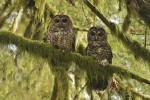A publication co-authored by a team of Oregon State University, US Forest Service, and US Geological Survey investigators compares quality of interpretation of northern spotted owl habitat based on traditional aerial photographs, Landsat satellite imagery, and recently-available, high-resolution LiDAR data. This team, led by Steve Ackers, head of the spotted owl crew based at the HJ Andrews Forest (AND) Long Term Ecological Research (LTER) site, uses the well-studied Blue River-Andrews Forest area as a test case. Information from these data sources is used in sophisticated species distribution models for the spotted owl and many other species .
As one might expect, each information source has its pros and cons. Air photo interpretation is rather subjective, hard to reproduce, and time consuming. Landsat has proven an adequate tool for extensive assessment of habitat quality, although it lacks the high precision possible with LiDAR. It is interesting to note that the first Landsat Thematic Mapper satellite was launched in 1972, just as Eric Forsman began studies of the spotted owl in the Andrews Forest and vicinity, and the first report using that imagery in habitat assessment appeared just two years later. The meter-scale LiDAR data describing topography and vegetation structure makes possible a very refined depiction of habitat, but LiDAR data are not available for the whole region, and the high precision is not necessary for many conservation purposes.
For more information see The evolution of mapping habitat for northern spotted owls (Strix occidentalis caurina): A comparison of photo-interpreted, Landsat-based, and LiDAR-based habitat maps. http://www.sciencedirect.com/science/article/pii/S0034425714003708

 Enlarge this image
Enlarge this image